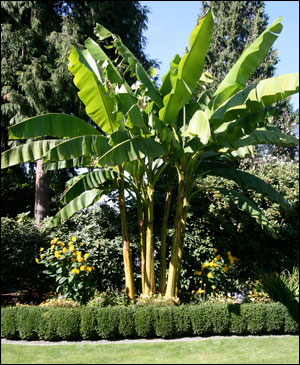Bananas

Bananas are grown both for their edible and ornamental qualities. They can be grown in nearly all areas of the state, though they will be damaged by frosts and freezes.
Characteristics
Bananas are plants that can easily lend a lush look to your landscape, thanks to their oversized leaves. They look great paired with gingers or other tropical ornamentals.
From an ornamental standpoint, several banana varieties are favored for their ability to withstand colder temperatures. These plants may lose their leaves during cold winters, but will usually put out new growth in the spring.
The cultivar ‘Dwarf Cavendish’ (Musa acuminata) is widely available and can be grown throughout Florida. It can produce tasty fruit if it doesn’t freeze back in the winter.
Pink velvet banana (Musa velutina) produces fruits that have a bright pink outer peel.
The most cold-hardy option is the Japanese fiber banana (Musa basjoo), which can survive in areas that receive sub-zero temperatures.
One more cold hardy banana is black Thai (Musa balbisiana). Keep in mind that many of these are ornamental bananas, and aren’t good for eating.
And of course, bananas can also be grown for their tasty fruits. Although supermarkets usually carry just one or two types, bananas come in a range of cultivar types that vary greatly in plant size and fruit flavor. Popular cultivars for eating include ‘Lady Finger’, ‘Apple’, and ‘Ice Cream’.
If temperatures drop below freezing, all of these plants will turn brown. However, they typically come back in the spring.
And although not technically bananas, Abyssinian banana (Ensete ventricosum), musella, and ensete all look like bananas and can take the cold.
Planting and Care

Musa basjoo is one of the most cold-hardy bananas.
Bananas will perform best when they’re planted in a moist, fertile soil in a wind-protected location that receives full sun. Since most soils in Florida are sandy and have low fertility, bananas need to be fertilized frequently (4 to 6 times per year) to have high growth and production rates. Young plants should be fertilized with one-half pound of 6-2-12 fertilizer every two months, and increasing gradually to five pounds at flowering and fruiting time.
Bananas also need regular watering and prefer to receive one to one and a half inches of water each week. If bananas don’t get enough water, they can be slow to fruit, will produce small or otherwise inferior fruit, or have low yields. At the same time, it’s important not to overwater, since continuously wet soils can harm the plants.
A key feature is the banana’s rhizomatous root system, which puts up new stalks each year. For good fruit production, it helps to limit the plant to three or four stalks that are different ages. The oldest and tallest one should be flowering and/or fruiting. The second one should be one-half to one-third the size of the first. And finally, there should be one or two young plants that are six inches to three feet tall.
Bananas in South Florida should also be watched for signs of nematode damage or symptoms of fusarium wilt and sigatoka disease.
For more information about bananas, contact your county Extension office.
